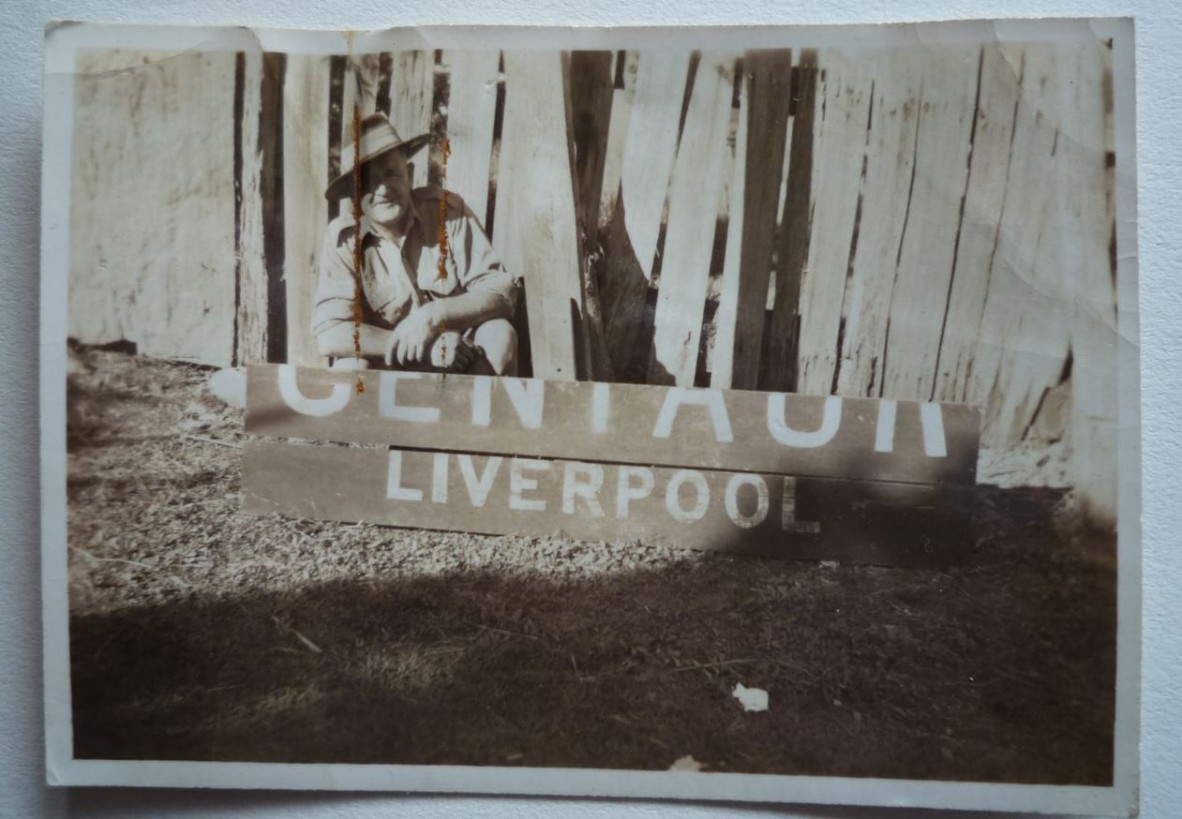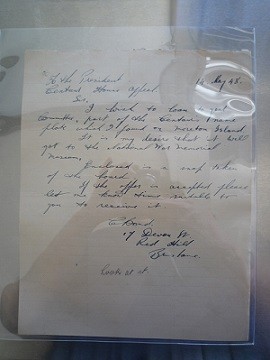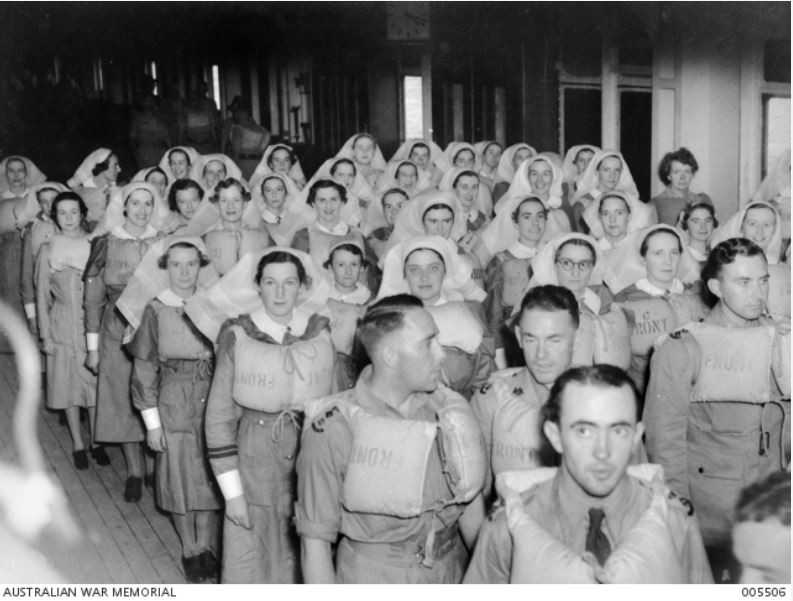Flotsam from the 2/3 Australian Hospital Ship Centaur
By JOL Admin | 21 September 2017
In this Centaur story, Dr Madonna Grehan, 2015 John Oxley Fellow, provides context for a photograph in the Centaur Memorial Fund collection at SLQ.

Photograph from the Centaur Memorial Fund collection, State Library of Queensland
This small snapshot shows a timber name-board from the 2/3 Australian Hospital Ship Centaur. In the Centaur Memorial Fund’s collection held at State Library of Queensland, this photograph was loose, with a rusty paper clip attached, and no annotation. Following an examination of the Fund’s entire records during 2015-2016, the loose photo was reunited with a letter in a correspondence folder for 1948. Reuniting the two items has made it possible to understand why the photo is in the Fund records.
An account of the photo’s history is found on Peter Dunn’s WWII website Australia@War, in a short article by Jim Bond, son of the soldier pictured.1 Jim Bond’s father, Sergeant Christopher Bond, was a member of the Australian Army Medical Corps in WWII. In May 1943 Sergeant Bond was on Moreton Island as an inspector with the Australian Army Hygiene Service, tasked with malaria prevention. Bond patrolled the island a week at a time, by horse, looking for potential breeding grounds of the Anopheles mosquito.
On the morning of 14 May, 2/3 Australian Hospital Ship Centaur was torpedoed east of Moreton Island and sank rapidly. During a patrol some days later, Chris Bond found the ship’s name-board washed up on the island’s eastern beach. He delivered the signage to his unit office at Cowan Cowan, only to discover it later, discarded on a carpenter’s wood heap. With permission, Bond retrieved the sign, wrapped it in hessian, and took it to the family home in Brisbane. As Jim Bond reported, after the war, it was delivered to a fete held at the Kelvin Grove Army Barracks.

Letter from the Centaur Memorial Fund collection, State Library of Queensland
The original letter (pictured) confirms some of these details. Written by Sergeant Chris Bond of 17 Devon Street, Red Hill, the correspondence is dated 14 May 1948. That was the first official commemoration of Centaur Day in Queensland. The letter reads “To the President, Centaur Home Appeal, I wish to loan to your committee part of the Centaur’s name plate which I found on Moreton Island. It is my desire that it will go to the National War Memorial Museum. Enclosed is a snap taken of the board. If the offer is acceptable please let me know time suitable to you to receive it.” At the bottom of the letter, R.C. Hancock, Chairman of the Fund’s Executive, has pencilled “Look at it”. It seems likely that Chris Bond took the sign to Kelvin Grove Barracks on 5 June 1948. On that day, a monster fete was held at the Barracks for the benefit of Matron Sadie Macdonald RRC, an entrant in the Queen of the Nurses Quest. Sadie was sponsored by the Army in Queensland as “Nurse Army”.
A second Centaur-related item was offered to the Fund in May 1963. This one, a lifejacket, was tabled at an Executive meeting. It was delivered by Padre Ganley, the minister who officiated at the Centaur’s memorial service held annually at the Shrine. Ganley received it from Mrs Gertrude Gaydon of 5 Meteor Street, Coorparoo. Her son, Alastair Gaydon, found the jacket in May 1943 when he was part of an Army contingent searching Moreton Island’s foreshores for survivors of Centaur’s sinking.

8th Division soldiers and nurses doing lifeboat drill en route to Malaya February 1941, Australian War Memorial collection. Image No. 005506
For the Centaur Fund’s Executive in 1963, the lifejacket was a poignant artefact, a reminder of the fate of service personnel aboard the stricken ship twenty years earlier. Albert “Skip” Rees, a member of the Fund’s Executive, undertook to check if Centaur had been equipped with this particular type of jacket. Rees obviously saw this as an important task. His only son Robert, an Able Seaman, was killed in 1941 in the sinking of HMAS Sydney. Rees reported the opinion of Lieutenant Commander J.S. Ferguson RAN. Ferguson said that while the lifejacket probably was from the ship, it was a standard issue, without markings indicating its connection with Centaur. When offered to the Australian War Memorial, the item was rejected on these grounds, and the Fund elected to keep it. Neither the lifejacket nor the name-board form part of the Centaur Memorial Fund collection today.
Dr Madonna Grehan
Dr Madonna Grehan was the recipient of the 2015 John Oxley Library Fellowship. Her research articles on the Centaur Memorial Fund can be found here:
- ATNA Nurses’ Rest Home, 17-19 Mallon St, Bowen Hills
- Avenging the Nurses: Government’s response to the sinking of 2/3 Australian Hospital Ship Centaur
- Centaur Day, 14 May, and Red Roses for Remembrance
- Queen of the Nurses Quest
- Highlighting Queensland’s links to the Centaur Memorial Fund for Nurses
- How to crown a Queen
- Brisbane’s first street markets – The Spring Hill Fair
- The Diggers’ Friend: Sadie Charlotte Macdonald 1875-1970 (with Marg Doherty)
- Two men and a presentation cricket bat
- At the Brisbane Ekka, 1950-1977 – the Centaur Memorial Fund’s money spinner
- Fiesta Gardens 1948 – a touch of Hollywood at Slacks Creek (with Dr Hilda Maclean)
- Centaur House Memorial Hostel, Magnetic Island
- Centaur House, Mt Gravatt, 1949: Almost the first raffle of real estate in Queensland
- Centaur House, Queen St, Brisbane: A Memorial Edifice to Queensland’s Nurses in two World Wars
- A Centaur memorial event at State Library of Queensland, Monday 14 May 2018
- Centaur Memorial Fund For Nurses Records - Digitised @SLQ
- Centaur Day Commemorations 14 May
- Imagining Centaur
References
Comments
Your email address will not be published.
We welcome relevant, respectful comments.